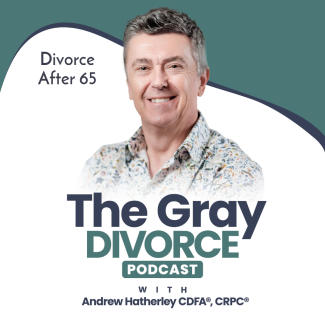
The Gray Divorce Podcast: Episode 13 Divorce After 65
Announcement: Welcome to The Gray Divorce Podcast, hosted by divorce financial analyst and retirement planning counselor Andrew Hatherley. Join Andrew and guest experts as they help late-life divorcees build the financial and mental foundation for a meaningful future. There is life after divorce. Now on to the show.
Andrew Hatherley: Hey everybody! Welcome to the Gray Divorce Podcast! Let's get right into lucky episode 13.
In 1990 the percentage of all persons divorcing over the age of 50 was 8.7%.
By 2010 27% of people getting divorced were aged 50 or older. And as of 2019 more than one in three or 36% of people getting divorced were aged 50 and older.
What I want to focus on today is a fact that maybe isn't as well known.
And that is that the group that's really driving the train for the increased divorce rate of adults aged 50 and older are older adults, adults aged 65 plus.
What a lot of people don't know is that since 2010 the gray divorce rate has really stagnated among middle-aged adults (50-64) but it continues to climb for the older group, those age 65 and up.
In today's episode I want to look at these statistics a little bit more closely and discuss the implications for those people getting divorced and maybe also for society as a whole.
I think it's important to give credit to the appropriate research sources. For this discussion, many of my statistics will be drawn from research report entitled “The Graying of Divorce 1a Half-Century of Change” by Susan brown and I-Fen Lin at Bowling Green State University and a report published by Pew Research Center written by Renee Stepler in 2017. The Brown/Lin paper was published in April 2022 in the Journals of Gerontology and can be seen as an update to a very influential paper written by the same authors in 2012 entitled “The Gray Divorce Revolution.” The 2012 paper was really the research that shined a light on the gray divorce phenomenon and has been widely quoted since.
The data for both those papers draws heavily from the American Community Survey in 2010 and 2019.
To begin, I think it's important to define exactly what is the divorce rate? What do we mean when we say the divorce rate is increasing?
What are the numbers we're talking about?
Well, the divorce rate is this: the number of people who divorced per 1000 married persons in the year prior to the survey among adults in that age group.
I'll say that again. The divorce rate is the number of people who divorced out of 1000 married people in the year prior to the survey among adults in that age group.
For example, from 1990 to 2015 the divorce rate for adults aged 25 to 39 dropped by 21% from 30 per 1000 to 24 for 1000.
Now, let's look at some specific numbers cited by Brown and Lin in their most recent research on middle-aged and older adults. This looks at the gray divorce rate by age group over half a century, from 1970 to 2019.
If we go back all the way to 1970 and look at the number of people divorcing per 1000 married people over the age of 50 the answer is 3.7.
So, 3.7 out of 1000 married people over the age of 50 were divorcing in 1970. Now, if we shoot forward all the way to 2019 that number grew to 9.6.
So, this is what really caught people's attention. That's more than a 2.5x increase in the divorce rate for people 50 and over from 1970 to 2019.
And as they noted in their research most of that growth came from around 1990 to the present.
Let's look at these statistics. If we look only at the older age group, 65 plus, excluding middle-aged divorcees aged 50 to 64 we'll see that the divorce rate for the 65 plus crowd (lets call them the older group) was 1.4 in 1970 but grew to 5.6 in 2019. That's a fourfold increase in the divorce rate for the older over 65 group versus 2 1/2 times for the whole gray divorce group age 50 plus.
Let's go a little deeper.
When Brown and Lin released their major report on gray divorce in 2012, they were looking at the divorce rates up to 2010.
Well, something very interesting has happened since 2010 to the present. The overall gray divorce rate has flattened. Actually, it's even dropped a little bit. In 2010 there were 10 people over age 50 divorcing out of 1000 married people but by 2019 it dropped a little bit. It was still high, but it dropped a little bit to the 9.6 number I mentioned a moment ago.
However, once again let's strip out the middle aged 50-64 group and look at the age 65 plus group. From 2010 to the present the divorce rate continued to increase from 4.8 per 1000 in 2010 to 5.6 per 1000 in 2019.
So, why is it that that older Americans from 65 years of age up continue to see increased rates of divorce while for middle-aged and younger Americans the numbers are stagnant or dropping?
Well, it's possible that baby boomers are to blame.
I know, OK boomer. The boomers get blamed for everything.
Brown and Lin note that there are distinctive marital biographies marked by exceptionally high levels of divorce and remarriage among Baby Boomers which have led to elevated levels of gray divorce during the second-half of life.
Indeed, baby boomers composed the middle age group, age 50 to 64, in their 2010 study that really put a spotlight on the gray divorce revolution. Unlike the baby boomers, subsequent generations such as Generation X born from 1965 to 1980 have come of age during an era of declining divorce and remarriage rates.
So, while the middle age group aged 50 to 64 was composed entirely of baby boomers in 2010, by 2019 much of this generation had aged into older adulthood, age 65 and older. Meanwhile, middle-aged people nowadays are starting to be replaced by members of the Generation X generation. This suggests that the divorce rate for the middle age group may continue to stagnate while gray divorce for older adults who are now primarily baby boomers continues to grow. It’s entirely possible that gray divorce will increasingly be dominated by older rather than middle-aged adults.
Ok, enough statistics. I can't promise no statistics, but I’ll lighten up a little bit.
I've mentioned in previous podcasts, there are special concerns of people getting divorced after 50.
Issues that are likely to be more prominent in a midlife divorce are likely to be even more exacerbated or take on a special character for a late life divorce after age 65. Especially when we consider that divorce leads to a declining standard of living for both parties. This decline happens to be more severe for women who experience a 45% decline in their standard of living versus the 21% drop for men according to recent research.
Let's look at life expectancy. A woman's life expectancy is 79 years in the United States while a man’s was about 73 years according to government data from 2021.
However, for men and women who are already 65 years of age the life expectancy goes up. This is a simple fact of actuarial tables - the longer we live the longer our life expectancy. So, the life expectancy for a woman who is now 65 is 86 years of age. And for a man it's 83 years of age.
For financial advisors such as myself, this has a big implication for retirement planning.
A divorced couple who is 65 are seeing their net worth essentially cut in half at a time when they're likely in retirement or very close to it. Now, granted, it's very likely that a 65-year-old couple has more assets to divide than a 40-year-old couple. What they don't have is as much time to build or rebuild those assets. So, it's extremely important that the marital property division and potential spousal support are structured in a way to provide the financial foundation for each individual's life over a planning horizon of at least 20 years, given life expectancy numbers. In fact, I would argue that most financial planners like me would tend to err on the side of conservatism and want to plan for 25 or 30 years from age 65.
If the truism that divorce represents the most important financial transaction in someone's life is, in fact true, and I would argue that it's truer than ever for a 65-plus divorcee looking at a potential 30-year retirement planning horizon.
One caveat that I would add to this discussion of 20-to-30-year retirement planning horizons is that many people are rethinking the idea of retirement. Many 65-year-olds in excellent health are still working. In fact, many are transforming the type of work or how they work to be more reflective of their passions, interests and personality. And in doing so they find that continuing to work is more satisfying than a life dedicated to playing golf or lying on the beach. There continuing to work generates an income that will reduce drawing down from retirement savings.
Of course, there's always an “on the other hand” and in this case the “on the other hand” is that some people may find it hard to adapt to new or different careers after late-life divorce and it may be harder to succeed the later in life one commences them.
At this point you might want to make a note and listen to episode 8 of the gray divorce podcast where we discussed the topic of retirement and work coaching with retirement and career coach Amy Ginsberg
Of course, not all 65-year-olds are alike. It’s more likely that a 65-year-old will be facing some sort of health issue than a younger divorcee. This is where issues such as the possible unavailability of health care benefits from a former spouse's employer can be an issue and, in some cases, even projected nursing home care costs can be an issue that wouldn't exist for a younger divorcee.
One area where older divorcees may have more flexibility is in the division of the family home, which typically would have built up more equity over time. In such cases couples over the age of 62 going through a divorce may be able to use a reverse mortgage to add more flexibility for their financial planning going forward. Now I know that historically reverse mortgages have been looked on as a somewhat sketchy product, or at least a product that has not always been sold in the most ethical manner. I've been doing some research on changes in the reverse mortgage industry, and I intend to bring some experts on to the gray divorce podcast in future episodes to discuss the development of this product over the years and how it might potentially benefit older divorcing couples with substantial equity in their homes.
Another issue is spousal support, commonly known as alimony. Depending on the state in which you are divorced, or the judge overseeing the case, alimony amounts maybe less due to a payor’s retirement or decrease in income.
There's also the potential loss or reduction of Social Security when a party remarries or receives benefits at an earlier age. Social Security is a complicated issue and I always recommend speaking to someone at the Social Security Administration about your case. But for starters you may want to visit Episode 3 of the gray divorce podcast which is dedicated to the issue of Social Security.
One other issue which I will be looking at on a future episode of the Gray Divorce Podcast Is the issue of estate planning and beneficiary designations for this older divorce group. The fact is, despite my earlier comments on life expectancy, both the divorcing party and their attorneys need to be aware of the greater possibility of death during the divorce process for the 65 + age group. The likelihood that there may be problems associated with the distribution of retirement accounts or insurance policies Is exacerbated for this group.
While I've been talking about the economic and health-related issues for the older divorcee, the psychological and social impact can be even greater.
Divorce can come as a far greater shock to the system if it's coming after a very long marriage. It's likely to challenge a person's view of the world and their role in life.
While the person initiating divorce may see it as an opportunity for growth or meaning or renewed purpose the other spouse may have a different view altogether and find themselves adrift.
We know that divorce’s impact on children, even if they are adults, can be divisive. And family friends may find it difficult to maintain a friendship with one or both parties after divorce.
A few minutes ago, I mentioned the economic penalty that women pay in gray divorce, with their standard of living declining on average 45% versus a decline of 21% for men.
Where men typically pay a more severe penalty is in this social realm.
Jocelyn Crowley, in her book Gray Divorce: What we Lose and Gain from Midlife Splits, speaks to this social penalty faced by men particularly:
Men, unlike women, tend not to have deeper networks of support to carry them through life transitions.
Men are more likely than women to fear complete abandonment by their adult children. For numerous reasons adult children tend to direct their negative responses toward their father more than their mother. This can also wreak havoc with a man’s economic well-being in older years as they switch care-related roles with their children.
Research has shown that women more often stated that their friends and adult family members sided with them over their ex-husbands in their gray divorce.
Women often tend to be the social organizers in a marriage thus leaving the man without training in this particular social skill.
Men, for a variety of reasons, find it more difficult to make friends with other men as easily as women make friends with other women. Men being men, they are less likely to share the pain they feel in this area.
In conclusion, the special concerns that gray divorcees may have versus younger people getting divorced is somewhat different for the oldest group of divorcees, those aged 65 and over. Some concerns may be more pronounced, others less so. And of course, each divorce has its own special circumstances.
It's important that divorce professionals: Divorce financial advisors, attorneys, divorce lending and real estate professionals, and therapists be sensitive to both the psychological and financial concerns of people in this age bracket.
That's it for this episode of the gray divorce podcast. If you'd like to learn more about how I help people before and during divorce, please visit my website wiserdivorcesolutions.com. And if you are emerging from mid to late-life divorce and are looking to establish the financial foundation for a meaningful life going forward, please visit me on transcendretirement.net
Until next time, take care.
Announcement: Thanks so much for tuning into this episode of The Gray Divorce Podcast. To learn more or get in contact with your host, you can visit Andrew's website at TranscendRetirement.net. Also, please feel free to rate, subscribe, and leave a review wherever you listen to your podcasts. That helps others find the show and we greatly appreciate it.
Thanks again for listening, and we'll catch you in the next episode.
Andrew Hatherley: Information provided is educational only and should not be construed as legal or tax advice. Each situation is unique and should be discussed with your tax or legal advisor prior to implementation. Andrew Hatherley is not an attorney and does not provide legal advice. Information provided is financial in nature.
Advisory services offered through Haly Capital Management LLC. Divorce Financial Analysis Services offered through Wiser Divorce Solutions an affiliated company.

